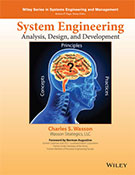System Engineering and Development - Textbook Table of Contents
System Analysis, Design, and Development is composed of Parts 1 and 2, organized into a collection of series, each consisting of one or more chapters on related topics.
INTRODUCTION
- What Is SE?
- About this Book
- What Is a System?
- System Attributes, Characteristics, and Properties
- System Roles & Stakeholders
- System Acceptability
- The System/Product Life Cycle
- The Architecture of Systems
- System Architecture Levels of Abstraction & Semantics
- The System of Interest Architecture
- The Operating Environment Architecture
- System Interfaces
- Organizational Roles, Missions, & System Applications
- Understanding the Opportunity, Problem, & Solution Spaces
- System Interactions with its Operating Environment
- Mission Analysis
- System Use Cases and Scenarios
- System Operations Model
- System Phases, Modes, & States of Operation
- Modeling System & Support Operations
- System Operational Capability Derivation and Allocation
- The Anatomy of a System Capability
- System Analysis Synthesis
- The System Development Workflow Strategy
- System Design, Integration, and Verification Strategy
- The SE Process Model
- System Development Models
- Specification Practices
- Understanding Specification Requirements
- Specification Analysis Practices
- Requirements Derivation, Allocation, Flow Down, and Traceability
- Specification Development
- Operational Utility, Suitability, and Effectiveness Practices
- System Design To/For Objectives Practices
- System Architecture Development Practices
- Requirements Domain Solution Development Practices
- Operations Domain Solution Development Practices
- Behavioral Domain Solution Development Practices
- Physical Domain Solution Development Practices
- Component Selection and Development Practices
- System Configuration Identification Practices
- System Interface Analysis, Design, & Control Practices
- Human-System Interface Practices
- Engineering Standards, Frames of Reference, & Conventions Practices
- System Engineering and Development Documentation Practices
- Analytical Decision Support Practices
- Statistical Influences on System Design Practices
- System Performance Analysis, Budgets, & Design Safety Margins Practices
- System Reliability, Availability, & Maintainability (RAM) Practices
- System Modeling and Simulation
- Trade Study Practices
- System Verification & Validation
- Technical Review Practices
- System, Integration, Test, & Evaluation (SITE) Practices
- System Deployment Practices
- System Operations & Support (O&S) Practices
PART 1 - SYSTEM ANALYSIS CONCEPTS
System Entity Concepts Series
System Architecture Concepts Series
System Mission Concepts Series
System Operations Concepts Series
System Capability Concepts Series
System Concept Synthesis
PART 2 - SYSTEM DESIGN & DEVELOPMENT PRACTICES
System Development Strategies Series
System Specification Series
System Development Series
Decision Support Series
Verification & Validation Series
System Deployment, Operations, & Support Series
Epilog

